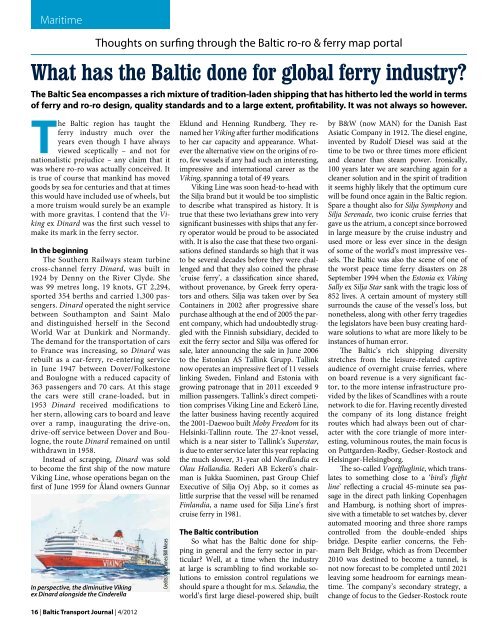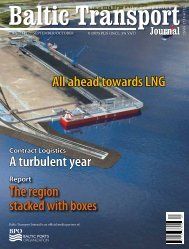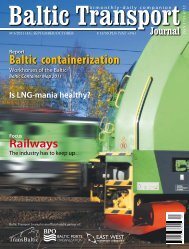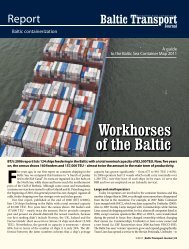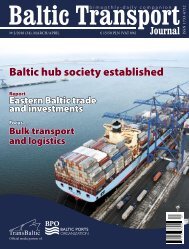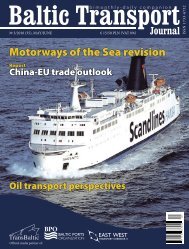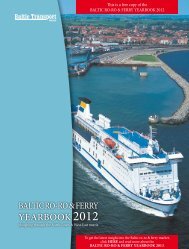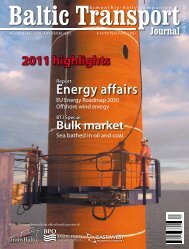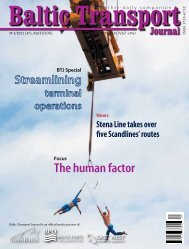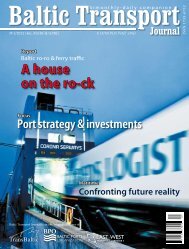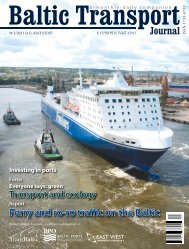What has the Baltic done for global ferry industry? - Baltic Press
What has the Baltic done for global ferry industry? - Baltic Press
What has the Baltic done for global ferry industry? - Baltic Press
- No tags were found...
Create successful ePaper yourself
Turn your PDF publications into a flip-book with our unique Google optimized e-Paper software.
MaritimeThoughts on surfing through <strong>the</strong> <strong>Baltic</strong> ro-ro & <strong>ferry</strong> map portal<strong>What</strong> <strong>has</strong> <strong>the</strong> <strong>Baltic</strong> <strong>done</strong> <strong>for</strong> <strong>global</strong> <strong>ferry</strong> <strong>industry</strong>?The <strong>Baltic</strong> Sea encompasses a rich mixture of tradition-laden shipping that <strong>has</strong> hi<strong>the</strong>rto led <strong>the</strong> world in termsof <strong>ferry</strong> and ro-ro design, quality standards and to a large extent, profitability. It was not always so however.The <strong>Baltic</strong> region <strong>has</strong> taught <strong>the</strong><strong>ferry</strong> <strong>industry</strong> much over <strong>the</strong>years even though I have alwaysviewed sceptically – and not <strong>for</strong>nationalistic prejudice – any claim that itwas where ro-ro was actually conceived. Itis true of course that mankind <strong>has</strong> movedgoods by sea <strong>for</strong> centuries and that at timesthis would have included use of wheels, buta more truism would surely be an examplewith more gravitas. I contend that <strong>the</strong> Vikingex Dinard was <strong>the</strong> first such vessel tomake its mark in <strong>the</strong> <strong>ferry</strong> sector.In <strong>the</strong> beginningThe Sou<strong>the</strong>rn Railways steam turbinecross-channel <strong>ferry</strong> Dinard, was built in1924 by Denny on <strong>the</strong> River Clyde. Shewas 99 metres long, 19 knots, GT 2,294,sported 354 berths and carried 1,300 passengers.Dinard operated <strong>the</strong> night servicebetween Southampton and Saint Maloand distinguished herself in <strong>the</strong> SecondWorld War at Dunkirk and Normandy.The demand <strong>for</strong> <strong>the</strong> transportation of carsto France was increasing, so Dinard wasrebuilt as a car-<strong>ferry</strong>, re-entering servicein June 1947 between Dover/Folkestoneand Boulogne with a reduced capacity of363 passengers and 70 cars. At this stage<strong>the</strong> cars were still crane-loaded, but in1953 Dinard received modifications toher stern, allowing cars to board and leaveover a ramp, inaugurating <strong>the</strong> drive-on,drive-off service between Dover and Boulogne,<strong>the</strong> route Dinard remained on untilwithdrawn in 1958.Instead of scrapping, Dinard was soldto become <strong>the</strong> first ship of <strong>the</strong> now matureViking Line, whose operations began on <strong>the</strong>first of June 1959 <strong>for</strong> Åland owners GunnarIn perspective, <strong>the</strong> diminutive Vikingex Dinard alongside <strong>the</strong> Cinderella16 | <strong>Baltic</strong> Transport Journal | 4/2012Credits: Ossie Jones/Bill MosesEklund and Henning Rundberg. They renamedher Viking after fur<strong>the</strong>r modificationsto her car capacity and appearance. <strong>What</strong>ever<strong>the</strong> alternative view on <strong>the</strong> origins of roro,few vessels if any had such an interesting,impressive and international career as <strong>the</strong>Viking, spanning a total of 49 years.Viking Line was soon head-to-head with<strong>the</strong> Silja brand but it would be too simplisticto describe what transpired as history. It istrue that <strong>the</strong>se two leviathans grew into verysignificant businesses with ships that any <strong>ferry</strong>operator would be proud to be associatedwith. It is also <strong>the</strong> case that <strong>the</strong>se two organisationsdefined standards so high that it wasto be several decades be<strong>for</strong>e <strong>the</strong>y were challengedand that <strong>the</strong>y also coined <strong>the</strong> phrase‘cruise <strong>ferry</strong>’, a classification since shared,without provenance, by Greek <strong>ferry</strong> operatorsand o<strong>the</strong>rs. Silja was taken over by SeaContainers in 2002 after progressive sharepurc<strong>has</strong>e although at <strong>the</strong> end of 2005 <strong>the</strong> parentcompany, which had undoubtedly struggledwith <strong>the</strong> Finnish subsidiary, decided toexit <strong>the</strong> <strong>ferry</strong> sector and Silja was offered <strong>for</strong>sale, later announcing <strong>the</strong> sale in June 2006to <strong>the</strong> Estonian AS Tallink Grupp. Tallinknow operates an impressive fleet of 11 vesselslinking Sweden, Finland and Estonia withgrowing patronage that in 2011 exceeded 9million passengers. Tallink’s direct competitioncomprises Viking Line and Eckerö Line,<strong>the</strong> latter business having recently acquired<strong>the</strong> 2001-Daewoo built Moby Freedom <strong>for</strong> itsHelsinki-Tallinn route. The 27-knot vessel,which is a near sister to Tallink’s Superstar,is due to enter service later this year replacing<strong>the</strong> much slower, 31-year old Nordlandia exOlau Hollandia. Rederi AB Eckerö’s chairmanis Jukka Suominen, past Group ChiefExecutive of Silja Oyj Abp, so it comes aslittle surprise that <strong>the</strong> vessel will be renamedFinlandia, a name used <strong>for</strong> Silja Line’s firstcruise <strong>ferry</strong> in 1981.The <strong>Baltic</strong> contributionSo what <strong>has</strong> <strong>the</strong> <strong>Baltic</strong> <strong>done</strong> <strong>for</strong> shippingin general and <strong>the</strong> <strong>ferry</strong> sector in particular?Well, at a time when <strong>the</strong> <strong>industry</strong>at large is scrambling to find workable solutionsto emission control regulations weshould spare a thought <strong>for</strong> m.s. Selandia, <strong>the</strong>world’s first large diesel-powered ship, builtby B&W (now MAN) <strong>for</strong> <strong>the</strong> Danish EastAsiatic Company in 1912. The diesel engine,invented by Rudolf Diesel was said at <strong>the</strong>time to be two or three times more efficientand cleaner than steam power. Ironically,100 years later we are searching again <strong>for</strong> acleaner solution and in <strong>the</strong> spirit of traditionit seems highly likely that <strong>the</strong> optimum curewill be found once again in <strong>the</strong> <strong>Baltic</strong> region.Spare a thought also <strong>for</strong> Silja Symphony andSilja Serenade, two iconic cruise ferries thatgave us <strong>the</strong> atrium, a concept since borrowedin large measure by <strong>the</strong> cruise <strong>industry</strong> andused more or less ever since in <strong>the</strong> designof some of <strong>the</strong> world’s most impressive vessels.The <strong>Baltic</strong> was also <strong>the</strong> scene of one of<strong>the</strong> worst peace time <strong>ferry</strong> disasters on 28September 1994 when <strong>the</strong> Estonia ex VikingSally ex Silja Star sank with <strong>the</strong> tragic loss of852 lives. A certain amount of mystery stillsurrounds <strong>the</strong> cause of <strong>the</strong> vessel’s loss, butnone<strong>the</strong>less, along with o<strong>the</strong>r <strong>ferry</strong> tragedies<strong>the</strong> legislators have been busy creating hardwaresolutions to what are more likely to beinstances of human error.The <strong>Baltic</strong>’s rich shipping diversitystretches from <strong>the</strong> leisure-related captiveaudience of overnight cruise ferries, whereon board revenue is a very significant factor,to <strong>the</strong> more intense infrastructure providedby <strong>the</strong> likes of Scandlines with a routenetwork to die <strong>for</strong>. Having recently divested<strong>the</strong> company of its long distance freightroutes which had always been out of characterwith <strong>the</strong> core triangle of more interesting,voluminous routes, <strong>the</strong> main focus ison Puttgarden-Rødby, Gedser-Rostock andHelsingør-Helsingborg.The so-called Vogelfluglinie, which translatesto something close to a ‘bird’s flightline’ reflecting a crucial 45-minute sea passagein <strong>the</strong> direct path linking Copenhagenand Hamburg, is nothing short of impressivewith a timetable to set watches by, cleverautomated mooring and three shore rampscontrolled from <strong>the</strong> double-ended shipsbridge. Despite earlier concerns, <strong>the</strong> FehmarnBelt Bridge, which as from December2010 was destined to become a tunnel, isnot now <strong>for</strong>ecast to be completed until 2021leaving some headroom <strong>for</strong> earnings meantime.The company’s secondary strategy, achange of focus to <strong>the</strong> Gedser-Rostock route
Maritime<strong>has</strong> been disappointingly tainted by shipyarddelays affecting two newbuilds, <strong>the</strong> Copenhagenand Berlin, both of which are subjectto late delivery by <strong>the</strong> builders, P+S Werftenof Stralsund, Germany. One of <strong>the</strong> problemsassociated with key, volume routes is <strong>the</strong>irsusceptibility to talk of fixed links and Gedser-Rostock<strong>has</strong> been no exception althoughScandlines EUR 230 million investment invessels and infrastructure should fend-offany thought of a bridge or tunnel.Scandlines impressive ‘magnet’, <strong>the</strong> Border Shop inPuttgardenPhoto: Bill MosesWhere only ‘ferries’ dareThe <strong>Baltic</strong> markets served by <strong>ferry</strong> operators(large and small) are not vast, a factorthat never<strong>the</strong>less staves off <strong>the</strong> advanceof dense population hungry low-cost airlineswhich have taken <strong>the</strong>ir toll of surface operatorselsewhere in Europe. Equally importantis <strong>the</strong> ‘city centre to city centre’ geography and<strong>for</strong> overnight services <strong>the</strong> opportunity to turnA2B travel into an enjoyable leisure experiencewith a range of facilities that often surpassthose on offer ashore. Where <strong>the</strong> increasingimportance of freight <strong>has</strong> underpinneddownward pressure on passenger ticket priceselsewhere in Europe, so on board sales, bothretail and food and beverage, supported byÅland Island duty free calls, more than makeup <strong>for</strong> lower freight demand in <strong>the</strong> north <strong>Baltic</strong>’sovernight cruise <strong>ferry</strong> sector.Tab. 1. Main market population, Denmark, Estonia,Finland & SwedenMain marketsPopulation (mln)Denmark 5.6Estonia 1.3Finland 5.4Sweden 9.5Source: VariousThe <strong>Baltic</strong> region passenger <strong>ferry</strong> market,supported by a wide and varied route networkis approaching 50 million passengers, a remarkablefigure given <strong>the</strong> population size. Freightthroughput in 2011 slightly exceeded 3.5 millionunits, a figure in comparative terms broadlyequivalent to <strong>the</strong> volume handled on <strong>the</strong> NorthSea, Dover Strait and Western Channel.Fig. 1.Top 6 <strong>ferry</strong> operators’ passenger volumes (mln)Source: <strong>Baltic</strong> Ro-ro & Ferry Yearbook 2012Fig. 2. Top 6 <strong>ferry</strong> operator freight volumes (thou. units)Source: <strong>Baltic</strong> Ro-ro & Ferry Yearbook 2012Stena Line, consisting of 32 ships on 17routes and representing 37% of parent companyStena AB, posted annual revenue of SEK9,684 million and a loss of SEK 366 millionin 2011. Stena operates a total of eight <strong>Baltic</strong>routes served by 16 vessels ranging from <strong>the</strong>impressive Scandlines-branded Skåne throughto <strong>the</strong> somewhat out-of-character MercandiaHH Ferries sisters on <strong>the</strong> 20-minute Helsingør-Helsingborgcrossing.Some operators have specialist tonnage toserve passenger and freight sectors althoughDanish operator DFDS <strong>has</strong> developed a networkthat takes it one stage fur<strong>the</strong>r sufficientto claim its status as nor<strong>the</strong>rn Europe’s largestintegrated shipping and logistics company.The company <strong>has</strong> a fleet of 41 ro-ro, ro-paxand passenger ferries of which 9 vessels comprisingtwo ro-ro and seven ro-pax are devotedto <strong>Baltic</strong> business units contributing18% of <strong>the</strong> 2011 shipping division revenue.In overall terms <strong>the</strong> shipping division madea return on capital (ROIC) of 10.2% downfrom 12% in 2010 and yet compared with <strong>the</strong>North Sea, Irish Sea and Channel, <strong>the</strong> <strong>Baltic</strong>per<strong>for</strong>mance was by far <strong>the</strong> best at 18.7%.Ano<strong>the</strong>r long standing, more freight orientated<strong>ferry</strong> operator, Finnlines, which is part of<strong>the</strong> Grimaldi Group, operates a fleet of around25 vessels with a network of over 20 ports of callin regular <strong>Baltic</strong> and North Sea liner services.The Finnlines Group recorded revenue totallingEUR 605.2 (561.1) million, an increase of 7.9%compared to 2010. Of this figure, shipping/seatransport services generated revenue of EUR563.3 (513.7) million and port operations EUR67.7 (72.3) million. The company’s result be<strong>for</strong>etaxes (EBT) was EUR -5.4 (3.7) million, reasons<strong>for</strong> which are cited as a port strike and ice conditionsearlier in 2011 and increased energy costs.One of Finnlines claims to fame was its prestigiousbut largely uneconomical addition to <strong>the</strong>fleet of Finnjet (or Jetti as some would call her).Built in 1977 she was <strong>the</strong> largest, longest andfastest car <strong>ferry</strong> of her day, with Pratt & Whitneygas turbines developing 55,000 kW drivingher at over 30-knots and cutting <strong>the</strong> Helsinki-Travemünde route from 36 to 22 hours.Burning around 300-tonnes of fuel <strong>for</strong> asingle trip was nei<strong>the</strong>r good economics or environmentallysustainable, talking of which <strong>the</strong>race <strong>for</strong> scrubbers, dry or wet is on in <strong>the</strong> <strong>industry</strong>’sattempt to find <strong>the</strong> most workable andcost-effective solution. With nearly as manypreferences <strong>for</strong> a way <strong>for</strong>ward as <strong>the</strong>re are <strong>ferry</strong>operators, ranging from LPG through to use ofeven heavier and cheaper heavy oil with addedpurification or something closer to ‘do nothing’by converting to MGO at <strong>the</strong> last minute ifnothing else seems suitable, <strong>the</strong> jury is still out.With wet scrubber installation costing aboutUSD 1.8 million per 15,000 kW <strong>the</strong> pressureon an already challenged <strong>industry</strong> is considerableand may push some too far. O<strong>the</strong>rs willdoubtless attempt to pass on increased operatingcosts to passenger and freight clients whichmight in turn convert some, where practicallypossible to overland. <strong>What</strong> price environmentalsolutions <strong>the</strong>n?Alas Jetti is no more, <strong>the</strong> route years lateris plied by Italian built ro-pax vessels of <strong>the</strong>so-called Star Class, each with capacity <strong>for</strong> 550passengers and an impressive 4,200 lane metresof vehicle deck space. At 25-knots <strong>the</strong> journeynow takes 28 hours. In summary, <strong>Baltic</strong>services are a traditional way of life fashionedoriginally by impressive shipping leviathanssuch as Johnson Line, Effoa, Bore, Svea ando<strong>the</strong>rs, <strong>for</strong> convenience, reliability and qualityservice, hallmarks of an efficient and valuedinfrastructure that users respect and rewardwith reciprocal loyalty and repeat bookings.<strong>Baltic</strong> <strong>ferry</strong> services are inspirational, innovativeand <strong>for</strong> <strong>the</strong> most part, indispensible. Bill MosesBill Moses <strong>has</strong> had considerable experienceat senior management and board level runninglarge passenger and freight shippingbusinesses including high profile servicesoperated by Hoverspeed, Sealink, Stena Line,Sally Line and Olau Line. He is now responsible<strong>for</strong> Drewry Shipping Consultants’ Ferry& RoRo division providing advisory services<strong>global</strong>ly to governments, commercial undertakingsand financial institutions. Bill wasawarded a M.B.E. medal by Her Majesty <strong>the</strong>Queen in 2008 <strong>for</strong> services to shipping businessand charitable work and gained a PhDfrom <strong>the</strong> University of Greenwich in 2011 <strong>for</strong>his <strong>the</strong>sis entitled The Commercial & TechnicalEvolution of <strong>the</strong> Ferry Industry 1948-1987.4/2012 | <strong>Baltic</strong> Transport Journal | 17


